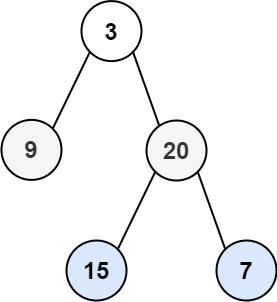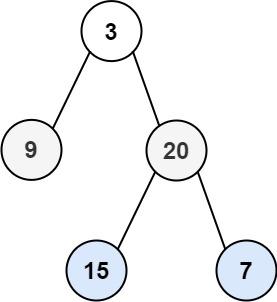层序遍历
102. Binary Tree Level Order Traversal
Given the root of a binary tree, return the level order traversal of its nodes’ values. (i.e., from left to right, level by level).
Example 1:

Input: root = [3,9,20,null,null,15,7]
Output: [[3],[9,20],[15,7]]
Example 2:
Input: root = [1]
Output: [[1]]
Example 3:
Input: root = []
Output: []
Constraints:
- The number of nodes in the tree is in the range
[0, 2000]. -1000 <= Node.val <= 1000
题解
解题思路
首先,通过构建和维护一个bfs队列来执行层序遍历;在此基础上,在bfs队列中每一层的末尾加入NULL来指示这一层的结束。
首先在bfs队列中入队root和null,即第一层的内容.在之后的循环中,不断移出队首的元素并将其子节点加入队列。使用一个额外的vector记录每一层的节点值(val),如果判断某一个节点是这一层的最后一个节点(即bfs队列中其下一位是null),则把这个vector的内容作为这一层的内容,并把vector清空,准备承接下一层的内容。同时,如果判断某一个节点是这一层的最后一个节点,需要在子节点入队后额外入队一个null标志下一层的结束。通过维护bfs队列中的null标志,可以
在实现时注意到,最后的空层会连续地引入两个null为最终的终结。所以我们这里在result.push_back的时候不允许参数为空层。也可以通过检测到两个null时提前break掉循环的方式实现。
结果
执行用时 : 0 ms, 在所有 C++ 提交中击败了100.00%的用户
内存消耗 :14.1 MB, 在所有 C++ 提交中击败了24.42%的用户
代码
/**
* Definition for a binary tree node.
* struct TreeNode {
* int val;
* TreeNode *left;
* TreeNode *right;
* TreeNode(int x) : val(x), left(NULL), right(NULL) {}
* };
*/
class Solution {
public:
vector<vector<int>> levelOrder(TreeNode* root) {
vector<vector<int>> result;
vector<int> curr_level;
queue<TreeNode*> bfs_queue;
bfs_queue.push(root);
bfs_queue.push(NULL); // 标志本层的末尾
while(!bfs_queue.empty()){
TreeNode* curr_ptr = bfs_queue.front();
bfs_queue.pop();
if(curr_ptr == NULL){ // 如果某一层已经到末尾,则进行整理工作
if(!curr_level.empty())
result.push_back(curr_level);
curr_level.clear();
}
else{
curr_level.push_back(curr_ptr -> val);
if(curr_ptr -> left != NULL) bfs_queue.push(curr_ptr -> left);
if(curr_ptr -> right != NULL) bfs_queue.push(curr_ptr -> right);
if(bfs_queue.front() == NULL) bfs_queue.push(NULL); // 标志下一层的终结
}
}
return result;
}
};
正反交替层序遍历
103. Binary Tree Zigzag Level Order Traversal
Given the root of a binary tree, return the zigzag level order traversal of its nodes’ values. (i.e., from left to right, then right to left for the next level and alternate between).
Example 1:

Input: root = [3,9,20,null,null,15,7]
Output: [[3],[20,9],[15,7]]
Example 2:
Input: root = [1]
Output: [[1]]
Example 3:
Input: root = []
Output: []
Constraints:
- The number of nodes in the tree is in the range
[0, 2000]. -100 <= Node.val <= 100
题解
在102题的基础上,每次result.push_back的时候判断一下是否要reverse就行了。执行用时0ms,内存消耗13.8MB.
代码
/**
* Definition for a binary tree node.
* struct TreeNode {
* int val;
* TreeNode *left;
* TreeNode *right;
* TreeNode(int x) : val(x), left(NULL), right(NULL) {}
* };
*/
class Solution {
public:
vector<vector<int>> zigzagLevelOrder(TreeNode* root) {
vector<vector<int>> result;
vector<int> curr_level;
queue<TreeNode*> bfs_queue;
bfs_queue.push(root); // 第1层的内容是root和NULL
bfs_queue.push(NULL); // NULL标志本层的末尾
bool flag = true; // 决定从左向右还是从右向左
while(!bfs_queue.empty()){
TreeNode* curr_ptr = bfs_queue.front();
bfs_queue.pop();
if(curr_ptr == NULL){ // 如果某一层已经到末尾,则进行整理工作
if(!curr_level.empty()){
// 在下面的逻辑中,会出现对最后一个空层之后的层打NULL标签的情况,此时这种空层不能输出
if(!flag) reverse(curr_level.begin(),curr_level.end());
flag = !flag;
result.push_back(curr_level);
}
curr_level.clear();
}
else{
curr_level.push_back(curr_ptr -> val);
if(curr_ptr -> left != NULL) bfs_queue.push(curr_ptr -> left);
if(curr_ptr -> right != NULL) bfs_queue.push(curr_ptr -> right);
if(bfs_queue.front() == NULL) bfs_queue.push(NULL); // 标志下一层的终结
}
}
return result;
}
};








 本文介绍如何实现二叉树的层序遍历及正反交替层序遍历算法,包括详细的解题思路和C++代码实现。
本文介绍如何实现二叉树的层序遍历及正反交替层序遍历算法,包括详细的解题思路和C++代码实现。
















 237
237

 被折叠的 条评论
为什么被折叠?
被折叠的 条评论
为什么被折叠?








